Ioannis Psaromiligkos
Access Probability Optimization in RACH: A Multi-Armed Bandits Approach
Apr 18, 2025Abstract:The use of cellular networks for massive machine-type communications (mMTC) is an appealing solution due to the availability of the existing infrastructure. However, the massive number of user equipments (UEs) poses a significant challenge to the cellular network's random access channel (RACH) regarding congestion and overloading. To mitigate this problem, we first present a novel approach to model a two-priority RACH, which allows us to define access patterns that describe the random access behavior of UEs as observed by the base station (BS). A non-uniform preamble selection scheme is proposed, offering increased flexibility in resource allocation for different UE priority classes. Then, we formulate an allocation model that finds the optimal access probabilities to maximize the success rate of high-priority UEs while constraining low-priority UEs. Finally, we develop a reinforcement learning approach to solving the optimization problem using multi-armed bandits, which provides a near-optimal but scalable solution and does not require the BS to know the number of UEs in the network.
Load Estimation in a Two-Priority mMTC Random Access Channel
May 23, 2024Abstract:The use of cellular networks for massive machine-type communications (mMTC) is an appealing solution due to the wide availability of cellular infrastructure. Estimating the number of devices (network load) is vital for efficient allocation of the available resources, especially for managing the random access channel (RACH) of the network. This paper considers a two-priority RACH and proposes two network load estimators: a maximum likelihood (ML) estimator and a reduced complexity (RCML) variant. The estimators are based on a novel model of the random access behavior of the devices coupled with a flexible analytical framework to calculate the involved probabilities. Monte Carlo simulations demonstrate the accuracy of the proposed estimators for different network configurations.
Channel Estimation for Reconfigurable Intelligent Surface MIMO with Tensor Signal Modelling
Nov 01, 2023Abstract:We consider a narrowband MIMO reconfigurable intelligent surface (RIS)-assisted wireless communication system and use tensor signal modelling techniques to individually estimate all communication channels including the non-RIS channels (direct path) and decoupled RIS channels. We model the received signal as a third-order tensor composed of two CANDECOMP/PARAFAC decomposition terms for the non-RIS and the RIS-assisted links, respectively, and we propose two channel estimation methods based on an iterative alternating least squares (ALS) algorithm: The two-stage RIS OFF-ON method estimates each of the non-RIS and RIS-assisted terms in two pilot training stages, whereas the enhanced alternating least squares (E-ALS) method improves upon the ALS algorithm to jointly estimate all channels over the full training duration. A key benefit of both methods compared to the traditional least squares (LS) solution is that they exploit the structure of the tensor model to obtain decoupled estimates of all communication channels. We provide the computational complexities to obtain each of the channel estimates for our two proposed methods. Numerical simulations are used to evaluate the accuracy and verify the computational complexities of the proposed two-stage RIS OFF-ON, and E-ALS, and compare them to the traditional LS methods. Results show that E-ALS will obtain the most accurate estimate while only having a slightly higher run-time than the two-stage method.
CNN-based automatic segmentation of Lumen & Media boundaries in IVUS images using closed polygonal chains
Sep 29, 2023Abstract:We propose an automatic segmentation method for lumen and media with irregular contours in IntraVascular ultra-sound (IVUS) images. In contrast to most approaches that broadly label each pixel as either lumen, media, or background, we propose to approximate the lumen and media contours by closed polygonal chains. The chain vertices are placed at fixed angles obtained by dividing the entire 360\degree~angular space into equally spaced angles, and we predict their radius using an adaptive-subband-decomposition CNN. We consider two loss functions during training. The first is a novel loss function using the Jaccard Measure (JM) to quantify the similarities between the predicted lumen and media segments and the corresponding ground-truth image segments. The second loss function is the traditional Mean Squared Error. The proposed architecture significantly reduces computational costs by replacing the popular auto-encoder structure with a simple CNN as the encoder and the decoder is reduced to simply joining the consecutive predicted points. We evaluated our network on the publicly available IVUS-Challenge-2011 dataset using two performance metrics, namely JM and Hausdorff Distance (HD). The evaluation results show that our proposed network mostly outperforms the state-of-the-art lumen and media segmentation methods.
A Structurally Regularized CNN Architecture via Adaptive Subband Decomposition
Jun 29, 2023



Abstract:We propose a generalized convolutional neural network (CNN) architecture that first decomposes the input signal into subbands by an adaptive filter bank structure, and then uses convolutional layers to extract features from each subband independently. Fully connected layers finally combine the extracted features to perform classification. The proposed architecture restrains each of the subband CNNs from learning using the entire input signal spectrum, resulting in structural regularization. Our proposed CNN architecture is fully compatible with the end-to-end learning mechanism of typical CNN architectures and learns the subband decomposition from the input dataset. We show that the proposed CNN architecture has attractive properties, such as robustness to input and weight-and-bias quantization noise, compared to regular full-band CNN architectures. Importantly, the proposed architecture significantly reduces computational costs, while maintaining state-of-the-art classification accuracy. Experiments on image classification tasks using the MNIST, CIFAR-10/100, Caltech-101, and ImageNet-2012 datasets show that the proposed architecture allows accuracy surpassing state-of-the-art results. On the ImageNet-2012 dataset, we achieved top-5 and top-1 validation set accuracy of 86.91% and 69.73%, respectively. Notably, the proposed architecture offers over 90% reduction in computation cost in the inference path and approximately 75% reduction in back-propagation (per iteration) with just a single-layer subband decomposition. With a 2-layer subband decomposition, the computational gains are even more significant with comparable accuracy results to the single-layer decomposition.
Channel Estimation for Reconfigurable Intelligent Surface-Assisted Full-Duplex MIMO with Hardware Impairments
Jan 12, 2023Abstract:We consider the problem of channel estimation in a multiple-input-multiple-output (MIMO) full-duplex (FD) wireless communication system assisted by a reconfigurable intelligent surface (RIS) with hardware impairments (HI) occurring at the transceivers and RIS elements. We propose an unbiased channel estimator that requires knowledge of only the first and second order statistics of the HI, for which we derive closed form expressions. The proposed estimator reduces to the maximum likelihood estimator in the case of ideal hardware. We also describe a FD pilot scheme that significantly reduces the computational complexity of obtaining this channel estimate. We verify the performance of the estimator under varying conditions of transceiver and RIS HI via numerical simulations.
Energy-Efficient D2D-Aided Fog Computing under Probabilistic Time Constraints
Jan 07, 2022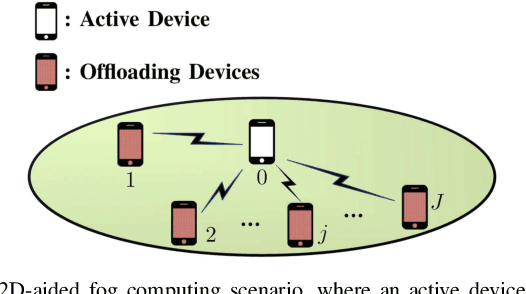
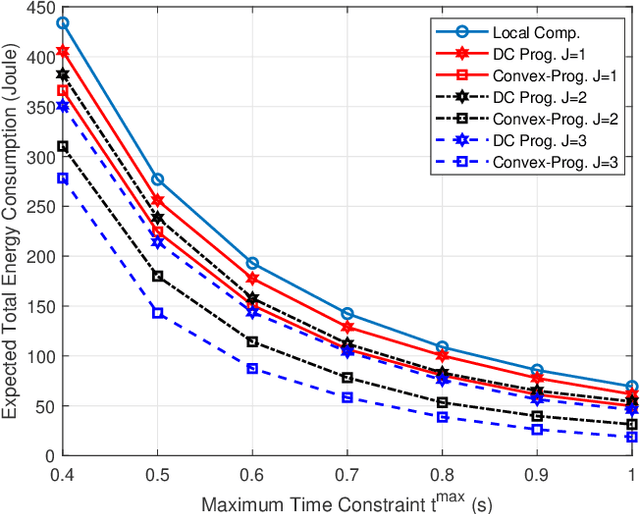
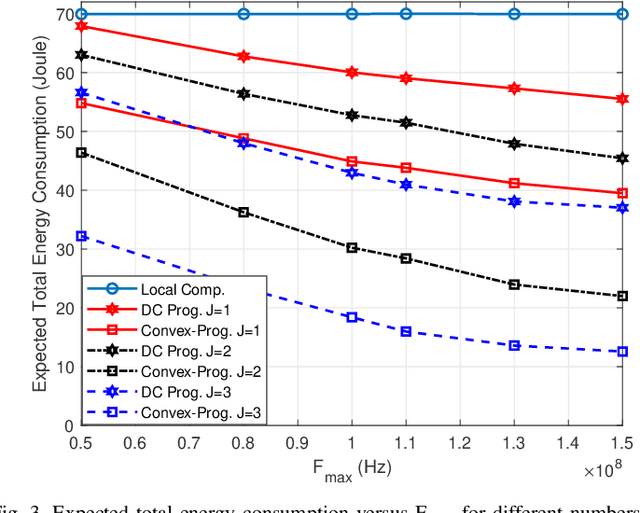
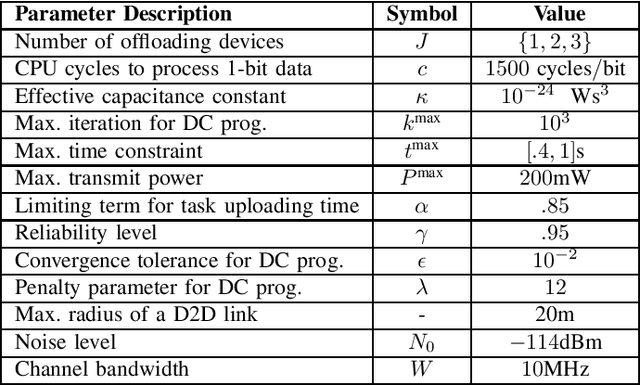
Abstract:Device-to-device (D2D) communication is an enabling technology for fog computing by allowing the sharing of computation resources between mobile devices. However, temperature variations in the device CPUs affect the computation resources available for task offloading, which unpredictably alters the processing time and energy consumption. In this paper, we address the problem of resource allocation with respect to task partitioning, computation resources and transmit power in a D2D-aided fog computing scenario, aiming to minimize the expected total energy consumption under probabilistic constraints on the processing time. Since the formulated problem is non-convex, we propose two sub-optimal solution methods. The first method is based on difference of convex (DC) programming, which we combine with chance-constraint programming to handle the probabilistic time limitations. Considering that DC programming is dependent on a good initial point, we propose a second method that relies on only convex programming, which eliminates the dependence on user-defined initialization. Simulation results demonstrate that the latter method outperforms the former in terms of energy efficiency and run-time.
A Structurally Regularized Convolutional Neural Network for Image Classification using Wavelet-based SubBand Decomposition
Mar 02, 2021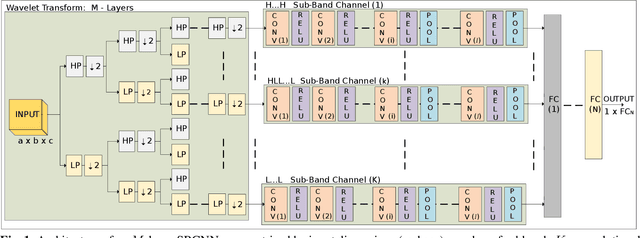
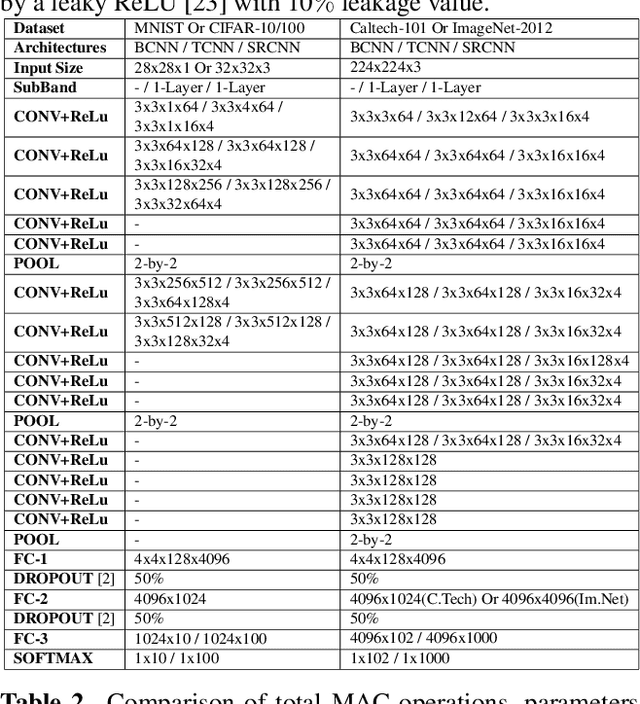
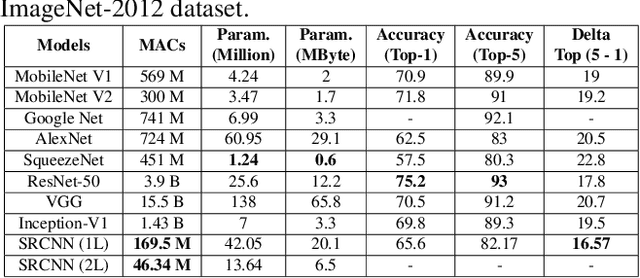

Abstract:We propose a convolutional neural network (CNN) architecture for image classification based on subband decomposition of the image using wavelets. The proposed architecture decomposes the input image spectra into multiple critically sampled subbands, extracts features using a single CNN per subband, and finally, performs classification by combining the extracted features using a fully connected layer. Processing each of the subbands by an individual CNN, thereby limiting the learning scope of each CNN to a single subband, imposes a form of structural regularization. This provides better generalization capability as seen by the presented results. The proposed architecture achieves best-in-class performance in terms of total multiply-add-accumulator operations and nearly best-in-class performance in terms of total parameters required, yet it maintains competitive classification performance. We also show the proposed architecture is more robust than the regular full-band CNN to noise caused by weight-and-bias quantization and input quantization.
 Add to Chrome
Add to Chrome Add to Firefox
Add to Firefox Add to Edge
Add to Edge